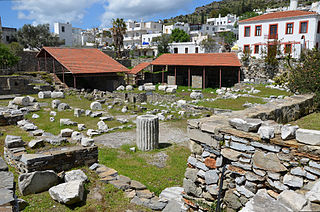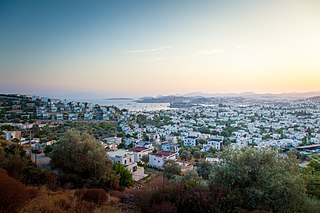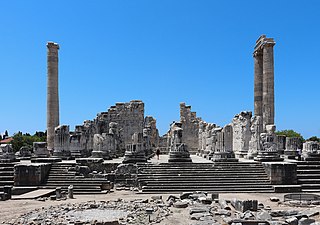
The Mausoleum at Halicarnassus or Tomb of Mausolus was a tomb built between 353 and 350 BC in Halicarnassus for Mausolus, an Anatolian from Caria and a satrap in the Achaemenid Empire, and his sister-wife Artemisia II of Caria. The structure was designed by the Greek architects Satyros and Pythius of Priene. Its elevated tomb structure is derived from the tombs of neighbouring Lycia, a territory Mausolus had invaded and annexed c. 360 BC, such as the Nereid Monument.

Caria was a region of western Anatolia extending along the coast from mid-Ionia (Mycale) south to Lycia and east to Phrygia. The Ionian and Dorian Greeks colonized the west of it and joined the Carian population in forming Greek-dominated states there. Carians were described by Herodotus as being of Minoan descent, while he reports that the Carians themselves maintained that they were Anatolian mainlanders intensely engaged in seafaring and were akin to the Mysians and the Lydians. The Carians spoke Carian, a native Anatolian language closely related to Luwian. Also closely associated with the Carians were the Leleges, which could be an earlier name for Carians.

Halicarnassus was an ancient Greek city in Caria, in Anatolia. It was located in southwest Caria, on an advantageous site on the Gulf of Gökova, which is now in Bodrum, Turkey. The city was famous for the Mausoleum of Halicarnassus, also known simply as the Tomb of Mausolus, whose name provided the origin of the word "mausoleum". The mausoleum, built from 353 to 350 BC, ranked as one of the seven wonders of the ancient world.

Muğla Province is a province and metropolitan municipality of Turkey, at the country's south-western corner, on the Aegean Sea. Its area is 12,654 km2, and its population is 1,048,185 (2022). Its seat is Muğla, about 20 km (12 mi) inland, while some of Turkey's largest holiday resorts, such as Bodrum, Ölüdeniz, Marmaris and Fethiye, are on the coast in Muğla.

Bodrum is a municipality and district of Muğla Province, Turkey. Its area is 650 km2, and its population is 192,964 (2022). It is a port city at the entrance to the Gulf of Gökova. Known in ancient times as Halicarnassus, the city was once home to the Mausoleum at Halicarnassus, also known as the tomb of Mausolus, one of the Seven Wonders of the Ancient World.

Bodrum Castle is a historical fortification located in southwest Turkey in the port city of Bodrum, built from 1402 onwards, by the Knights of St John as the Castle of St. Peter or Petronium. A transnational effort, it has four towers known as the English, French, German, and Italian towers, bearing the names of the nations responsible for their construction. The chapel was built around 1407 and the first walls completed in 1437. The castle started reconstruction in the late 14th century, only to be taken over by the Islamic Ottoman Empire in 1523. The chapel was converted to a mosque, and a minaret was added. The castle remained under the empire for almost 400 years. After remaining empty following World War I, in the early 1960s, the castle became the home for the Bodrum Museum of Underwater Archaeology. In 2016 it was inscribed in the UNESCO Tentative list of World Heritage Sites in Turkey.

Ada of Caria was a member of the House of Hecatomnus and ruler of Caria during the mid-4th century BC, first as Persian Satrap and later as Queen under the auspices of Alexander III of Macedon.
Satyros or Satyrus was a Greek architect in the 4th century BC. Along with Pythius of Priene, he designed and oversaw the construction of the Mausoleum at Halicarnassus.
Salih Ada is a Turkish island in the Aegean Sea, located north of Bodrum. It is located in the Muğla Province. It is located across Güvercinlik Bay on the Muğla-Bodrum highway. Salih Ada is a popular tourist destination, and is accessible by boat from Bodrum. The hills to the east of the island are covered with pine forest and olive groves.

Didim is a municipality and district of Aydın Province, Turkey. Its area is 424 km2, and its population is 97,000 (2022). It is a popular seaside holiday resort on the Aegean coast of western Turkey, 123 km (76 mi) from the provincial capital city of Aydın. Didim is the site of the antique city of Didyma with its ruined Temple of Apollo.

The Turkish Riviera, also known popularly as the Turquoise Coast, is an area of southwest Turkey encompassing the provinces of Antalya and Muğla, and to a lesser extent Aydın, southern İzmir and western Mersin. The combination of a favorable climate, warm sea, mountainous scenery, fine beaches along more than a 1,000 km (620 mi) of shoreline along the Aegean and Mediterranean waters, and abundant natural and archaeological points of interest makes this stretch of Turkey's coastline a popular national and international tourist destination.

Yılmaz Erdoğan is a Turkish filmmaker, actor and poet who is most famous for his box-office record-breaking debut comedy film Vizontele (2001) and the television series Bir Demet Tiyatro (1995–2002/2006–2007). He founded BKM Theatre and Film Production. He was awarded the Best Supporting Actor at 4th Australian Academy of Cinema and Television Arts Awards for his performance in The Water Diviner (2014).

The Cemil Topuzlu Open-Air Theatre is a contemporary amphitheatre located at Harbiye neighborhood of Şişli district in Istanbul, Turkey. It is situated across from the Istanbul Lütfi Kırdar Convention and Exhibition Center, and behind the Hilton Istanbul Bosphorus on the European side of the city.

Prusias ad Hypium was a city in ancient Bithynia, and afterwards in the late Roman province of Honorias. In the 4th century it became a bishopric that was a suffragan of Claudiopolis in Honoriade. Before its conquest by King Prusias I of Bithynia, it was named Cierus or Kieros and belonged to the Heraclea Pontica. Photius writes that it was called Kieros, after the river which flows by it.
Caryanda or Karyanda was a city on the coast of ancient Caria in southwestern Anatolia. Stephanus of Byzantium describes it as a city and harbour (λίμην) near Myndus and Cos. But λιμήν, in the text of Stephanus, is an emendation or alteration: the manuscripts use the word λίμνη ('lake'). Strabo places Caryanda between Myndus and Bargylia, and he describes it, according to the common text, as "a lake, and island of the same name with it;" and thus the texts of Stephanus, who derived his information from Strabo, agree with the texts of Strabo. Pliny simply mentions the island Caryanda with a town; but he is in that passage only enumerating islands. In another passage he mentions Caryanda as a place on the mainland, and Pomponius Mela does so too. Scylax of Caryanda, one of the most famous mariners and explorers of ancient times, was a native of Caryanda. He lived in the late 6th and early 5th centuries BC and served the Persian king Darius I.
Nevra Serezli is a Turkish film, stage, television and voice actress. Following her graduation from Robert College, she went on to study theatre. In 1965, she started working as a professional stage actress at the Dormen Theatre. Two years later, she appeared at the Ankara Art Theatre. Between 1971 and 1978, she performed in numerous plays with Altan Erbulak and Metin Serezli. In 1984, she registered with Devekuşu Kabare Tiyatrosu as an actress. She served at the Devekuşu Kabare until 1989. After reprising her duties at the Dormen Theatre in 1990, she joined the theatrical assembly called Tiyatro İstanbul. She gave lessons at the Language and Culture Centre (LCC).

The Roman Theatre of Orange is a Roman theatre in Orange, Vaucluse, France. It was built early in the 1st century AD. The structure is owned by the municipality of Orange and is the home of the summer opera festival, the Chorégies d'Orange.
Thera was a town of Ancient Caria. It is mentioned by Arrian as one of the towns held by Orontobates.
Kenter Theatre is a theatre located in Istanbul, Turkey established by Yıldız Kenter and Müşfik Kenter of the Kenter acting dynasty in 1968.

Ankara Roman Theater is the Ancient Roman Theater located between Hisar Street and Pınar Street in Ulus district of Altındağ district in Ankara, the capital city of Turkey. Although the exact date of construction is not known, it is dated to the 2nd century AD.



















